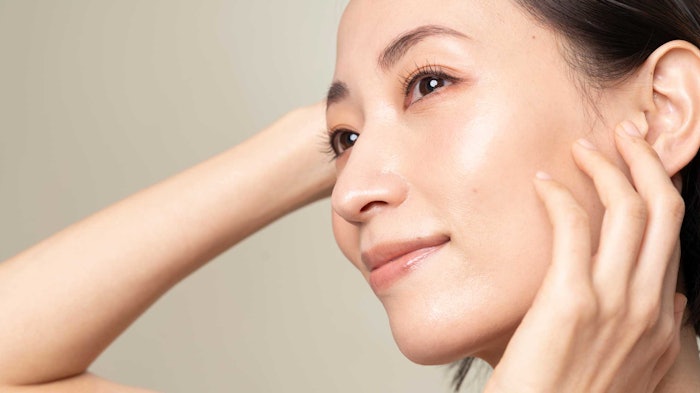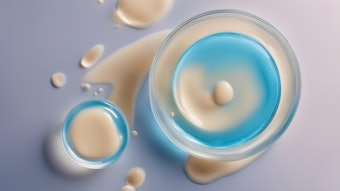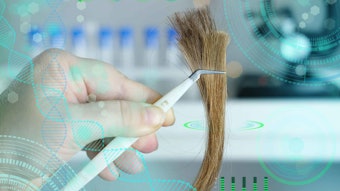
The K-beauty trend for flawless, “glass" skin aims to achieve a complexion so smooth, clear and luminous that it resembles a sheet of glass. This hydrated, even-toned skin with a natural glow, all indicators of health, is now more desired than ever. Makeup looks of admired celebrities such as Jennifer Lopez, Hailey Bieber and Bella Hadid reflect these radiant, fresh and minimalistic qualities.1 As such, this article explores the meaning of skin radiance, its relationship to texture, and various ways to measure this desired attribute.
Log in to view the full article
The K-beauty trend for flawless, “glass" skin aims to achieve a complexion so smooth, clear and luminous that it resembles a sheet of glass. This hydrated, even-toned skin with a natural glow, all indicators of health, is now more desired than ever. Makeup looks of admired celebrities such as Jennifer Lopez, Hailey Bieber and Bella Hadid reflect these radiant, fresh and minimalistic qualities.1 As such, this article explores the meaning of skin radiance, its relationship to texture, and various ways to measure this desired attribute.
Why do consumers covet flawless skin? It is scientifically proven that attributes of skin texture and radiance make faces appear more attractive.2 One study with 36 male and female college students explored the role of smooth texture and even color on attractiveness. It used various psychophysical tests such as forced choice, same/different and rating scale techniques.
Participants perceived:
- those facial skin images that were “touched up” to look more homogeneous and more attractive.
- This perception followed a logarithmic response, meaning that initial improvements in skin homogeneity significantly enhanced attractiveness, with additional improvements yielding diminishing returns.
- These findings underscore the importance of skin texture and radiance in beauty and suggest that even small improvements can impact perceived attractiveness.2
A similar study conducted with 160 female participants (ages 30-49) involved viewing images of ten female models (ages 30-44) with three types of skin reflection: radiant, oily/shiny and matte. Participants were asked to estimate the models’ ages and evaluated facial attractiveness as well as nine other impressions, including being likable, appearing healthy and having radiant skin.
The study concluded:
- that facial radiance significantly enhanced perceptions of attractiveness and various other impressions,
- with full-face radiance being the most effective.
- On the other hand, oily and shiny reflections tended to create negative impressions. These findings confirm the importance of skin radiance in shaping perceptions of beauty and justify current skin care trends.3
Defining Skin Radiance and Texture
Despite being an exploding trend in skin care,4, 5 skin radiance lacks consistent terminology.6 Therefore, before exploring how to measure skin radiance and the related characteristic of skin texture, it is important to define these concepts not only as they appear in the literature, but also based on feedback from industry experts – a few of whom we reached out to; their insights are included here.
Skin radiance: Humphrey, et al., proposed a framework describing skin attributes in three categories: visible/visual, mechanical and topographical. Defined as the ability of skin to “glow” or reflect light, radiance was said to fall under the visual category.6
Immunologist Ebru Karpuzoglu, Ph.D., an inflammaging and cosmetics formulation expert, describes radiance as not just a superficial trait, but the result of the complex interaction of skin's microstructural properties and its biochemical makeup causing the light to reflect evenly and creating a luminous and healthy look.7
Rania Ibrahim, Ph.D., a clinical director with more than ten years’ experience in skin measurement science, defines skin radiance as the glow one sees right after a facial or a thorough exfoliation.8
Nicolae Rita, a celebrity makeup artist and licensed aesthetician with 25 years field experience, emphasizes “smoothness” as an important factor for attaining radiance.1 This leads us to the related characteristic of skin texture.
Skin texture: The term texture is related to the roughness attribute of skin, which falls under both visible and topographical classifications, per Humphrey, et al.5 Karpuzoglu describes skin texture as the overall topographical structure and tactile sensation of the skin surface, including fine lines, wrinkles, pores and surface irregularities. Scientific evaluations of skin texture are based on parameters like smoothness, softness and uniformity of the skin surface, per Karpuzoglu.6
The Skin Texture/Radiance Intersection
While we just tried to tease out definitions of radiance and texture separately, these properties are interlinked both scientifically and as perceived by humans. Skin radiance is tightly connected to optical properties such as light scattering, reflection and absorption. These, in turn, are linked both to the skin’s surface texture and its underlying structures.9
The experts we contacted also agreed that texture and radiance attributes are interlinked. “Smoother, healthier, and hydrated skin tend to reflect light more evenly and efficiently, enhancing radiance,” said Karpuzoglu.6 Ibrahim added, “Typically, when we use exfoliating products to smooth and slough off dead skin and create a more even texture, we also see a decrease in dull appearance.”7 Rita agreed: “I refer to skin texture as the feel and look of it, smooth and hydrated versus bumpy, dry and flaky. I don’t think dehydrated, rough skin can be radiant.”1
A large-scale study of 1,058 women (ages 18-80) recruited from six countries (China, Japan, Korea, India, South Africa and Brazil) pointed to the interconnectedness of radiance and other skin attributes including texture.10 Full-face photographs of subjects were taken under standardized conditions. Twenty facial skin attributes ranging from fine lines and wrinkles to pigmentation were then graded by experts as well as 100 local women from each country. Evaluations were made for Perceived Radiance and Glow (PRG) and Perceived Age (PA).
The study concluded that PRG was strongly associated with PA, with decreased radiance indicating an older perceived age. Pigmentation, wrinkles/texture and ptosis/sagging were identified as key factors influencing radiance across different ethnic groups, with specifics varying by region.10
However interlinked these attributes may be, measuring and grading radiance and texture is accomplished separately. Skin radiance is typically measured via expert grading on a none-point scale, either from images or directly on subjects, according to Ibrahim. Skin texture, on the other hand, can be measured using either 2D or 3D imaging methods via instrumentation, or more subjectively by using tactile grading methods.7
Preclinical Testing for Radiance, Texture
Now that we’ve defined these attributes, we will take a closer look at techniques and combinations of methods employed to measure skin radiance and texture when studying product and ingredient efficacies.
Skin peels: Peels are cosmetics that resurface the skin and can help to improve both texture and radiance. Before conducting clinicals on an AHA and BHA peel, Namkoong, et al., first assessed the tolerability and efficacy of the product via preclinicals, employing extensive in vitro and ex vivo methodologies.11
Skin irritation biomarkers related to inflammation were evaluated by enzyme-linked immunoassays (ELISA) and quantitative reverse transcription polymerase chain reaction (RT-qPCR) using human skin explants from two female donors (ages 32 and 28). Studies were conducted in quadruplicate or triplicate. The IL-1α levels and gene expressions of IL1A, IL1B and IL6 in both the placebo- and test cream-treated samples showed no significant differences from the untreated sample, indicating the skin irritation potential of the peel to be low.11
Ex vivo tissue was further used to examine the potential benefits of the peel. Loricrin, a biomarker related to the formation and maintenance of the outer layer of skin, was evaluated using immunofluorescence staining. Compared with both the untreated and placebo samples, the cream significantly stimulated loricrin expression. Additionally, the impact on the skin’s antioxidant barrier was assessed by measuring SOD2 protein expression, which mitigates oxidative stress.11
An even skin tone, driven by melanin synthesis and distribution, also contributes to skin radiance. Aging causes discoloration due to melanin production dysregulation. To address this, various approaches are taken to reduce melanin production by inhibiting tyrosinase, a key enzyme in melanin synthesis. In vitro studies in darkly pigmented human melanocytes showed that while the placebo slightly suppressed tyrosinase activity, the peel significantly inhibited it.11
Anti-wrinkle active: A commercially available aqueous extract of holy basil was shown in vitro to protect mitochondria against oxidative stress. According to the maker, after these initial results, clinical tests carried out on the ingredient showed significant wrinkle reduction in crow's feet and forehead areas while also improving skin firmness and elasticity, visibly reducing redness and restoring skin’s radiance.12
Gel moisturizer: The efficacy of a gel matrix moisturizer was measured using ex vivo studies on human skin explants obtained from abdominoplasty. The explants were prepared, cleaned and mounted in Franz diffusion cells. Post-treatment, the skin sections were analyzed using confocal Raman microscopy.
The gel matrix formula increased the relative water content in the stratum corneum by 86%, per the authors, and in the viable epidermis by 18%, compared with the untreated control. These results encouraged the authors to move into clinical studies.13
Clinical Testing for Radiance, Texture
After initially proving the safety and efficacy of product concepts and ingredients, the next step is customarily to assess these properties in vivo using a combination of methodologies such as expert grading, bio instrumentation and imaging as well as subjective feedback collected from the study participants. Following are examples.
Micropeeling cream: After illustrating the potential of a micro-peeling cream on ex vivo tissue, Namkoong, et al., determined the cream’s in vivo efficacy in a clinical study of 36 subjects, phototypes II–VI (ages 50.0 ± 6.4). A dermatologist assessed skin radiance, homogeneity, wrinkle smoothness, skin imperfections and skin roughness of subjects on Days 1, 7 and 28.11
Skin homogeneity and lightness were measured using the L*a*b* color space with a chromametera at the same time points. Pore diameter measurements were also assessed by photographs at 30× magnification using a microscopeb on the left cheek area close to the nasal wing. Six to 10 measurements were performed per subject. The morphometric measurements were performed using software capable of measuring changes in pore diameter.11
To measure the quantity of removed corneocytes from the skin surface, a 22-mm adhesive discc was applied to the skin with standardized pressure on the left cheek area. The material was then placed on a black reading card and compared to a visual scale from 0 to 5.
Photographs, combined with stereovision technology to produce 3D-reproducible imagesd, were taken in the periocular areas; skin roughness measurements corresponded to the sum of the absolute positive volume and the absolute negative volume, divided by the overall surface area, to track changes in the depth of fine lines. All of the measured skin parameters showed significant improvements over the baseline, as well as throughout the study.11
Gel matrix formula: After initial findings, a single-center, full-face, 12-week clinical study assessed the efficacy of the gel matrix formula discussed above in female subjects aged 35-55 with self-perceived skin dryness and moderately dull skin. Subjects used the gel twice daily for 12 weeks. Instrumental, clinical, and self-assessments were conducted at baseline and after 1, 4, 8 and 12 weeks.
Significant improvements in skin surface hydration were observed as soon as the first week. Transepidermal water loss (TEWL) measurements indicated a significant improvement in skin barrier function after 12 weeks.
Dermatologist grading showed significant improvements in skin radiance, clarity, tactile texture and visual texture at all time points. By week 12, all subjects showed improvement in skin radiance, clarity, and texture. Most subjects agreed that the product improved skin hydration and radiance, and that their skin looked and felt smoother by the study’s end.13
Liposomal serum: In a 24-week clinical study of 123 women (ages 39-65), the anti-aging efficacy of a serum containing a liposomal blend (63 subjects) against its vehicle (60 subjects), was shown using several methodologies.
For example, an instrument with the ability to capture and generate a three-dimensional (3D) image of the face using multi-spectral lightinge was used to capture the facial images of 20 participants from each group at baseline, weeks 4, 8, 12 and 24. The images were further analyzed by the instrument’s software, which quantified several aging characteristics, including texture-related attributes such as total wrinkles, average wrinkle length and width, and fine lines.14
The same study employed a skin imaging technologyf to quantify melanin and collagen via spectrophotometric intracutaneous analysis; i.e., the instrument uses visible and infrared light (400 to 1,000 nm) through a skin-contact probe and chromophores like melanin absorb light, whereas collagen scatters it. By the study's end, no major differences in melanin content – and thus radiance – were observed.
Participants also filled out a self-assessment questionnaire on skin attributes such as lines, wrinkles, discolorations, complexion health and radiance. They reported improvements in texture/smoothness, radiance/luminosity, skin tone, lifting, complexion health and clarity.
Combining objective and subjective tests in clinical studies is effective, as complex attributes like radiance may not be captured by instruments alone but can be validated through self-assessment.14
Under-eye cream: The efficacy of an under-eye cream was evaluated in an open-label study of 40 female subjects with signs of aging in the periocular area. A 3D camerag was employed to measure the volume of the under-eye bags and skin smoothness via the Sa parameter (average deviation of profile height from the mean surface), and the wrinkle maximum depth in the periocular (crow’s feet) area.
The severity of dark circles was assessed employing the CIELab chromatic space using a spectrophotometer/colorimeterh. The skin radiance (or brightness, in this study) was measured using the 8-degree gloss parameter of the device.
In addition, clinical analysis carried out by a board-certified dermatologist using a four-point scale, along with a self-assessment questionnaire completed by each study subject. The authors concluded that the twice daily use of the test eye cream for 28 days showed statistically improved wrinkle depth, skin roughness and skin radiance. In addition, improvements in under-eye bags, elasticity, moisturization and dark circle reduction were measured.15
RHA serum: A split-face study in 24 female subjects (ages 35-55) investigated the ability of a cross-linked hyaluronic acid formulation (RHA serum) to enhance results from fillers, microneedling or chemical peeling. Previous comparative skin explant studies had demonstrated the greater efficacy of an RHA serum, compared with a non-cross-linked high or low molecular weight hyaluronic acid, to decrease transepidermal water loss, increasing epidermal hydration and improving corneocyte microstructure.
Eight subjects received intradermal hyaluronic acid filler injections, eight underwent microneedling and eight were treated with a chemical peel. Two days after the procedure, subjects began applying standardized RHA serum to one side twice daily. Topographical imaging, bio-instrumental and blinded clinical evaluations were performed on Days 0, 14 and 28.
Areas treated with the serum showed statistically significant improvements in skin surface topography and hydration, compared with untreated areas. Investigator scoring also showed greater improvement of the serum-treated sides in terms of moisture, tone/complexion, radiance, texture, uniformity and global appearance. Subjects’ questionnaire responses correlated with these findings.16
Nutricosmetic blend: Beyond topical treatments, nutritional supplements have gained popularity for improving skin quality. In a clinical study, 110 women (ages 45–60) were evenly split into treatment and placebo groups. The test product, a nutricosmetic blend of phytoestrogens and isoflavones, was administered over a 12-week period, with dermatological parameters evaluated at baseline and weeks six and 12. Additionally, glutathione (GSH) and malondialdehyde (MDA) levels were detected at baseline and Week 12 to evaluate the antioxidant status in subjects’ blood.
In addition to the instrumental methods outlined next, a dermatologist independently assessed skin attributes, and all blood work was carried out by a doctor and a research assistant. Subjects completed a self-evaluation questionnaire at the end of the study as well.17
Skin radiance was tracked using a glossmeterj, and the melanin index by a toolk that assesses skin tone. Skin texture was evaluatedm with microtopography device based on SALS variables: smoothness, roughness, scaliness and wrinkle density in the crow’s feet regions. Skin elasticity and hydration were also measured via customary bio-instrumental methods.
The test product improved skin elasticity, smoothness, scaliness and roughness over the placebo, despite intra-group variations. However, there were no significant differences in melanin index or gloss, and consumer self-assessments did not indicate improvements in skin radiance – with dark spots remaining a concern.
The study observed significant improvements in blood levels of GSH and MDA in the treatment group, suggesting benefits in oxidative radical reduction and protective mechanisms. The authors suggested that increased skin elasticity was likely due to the activation of estrogen receptor-β by soy isoflavones, stimulating collagen and elastin content.17
Collagen supplement: Another nutricosmetic, a skin radiance collagen (SRC), was assessed for its effects in 40 healthy adult women (ages 38 to 50) and compared with a placebo. Measurements were taken on Days 1, 28 and 56 for skin elasticity, hydration, brightness, pigmentation, texture, wrinkles, dryness, smoothness, fine lines, crow’s feet region, hair strength and hair fall. A colorimetern was used to measure skin color in the L*a*b color space on the right cheek, evaluating the individual typology angle (ITA) for skin tone. Another device with a high-resolution UVA light video camerao assessed skin surface attributes including wrinkles, fine lines and roughness.
Using Griffith’s Scale (0-9 points), the severity of photodamaged skin was graded for wrinkles, dyspigmentation, elastosis, roughness, pore size, telangiectasia, sallowness and laxity. Wrinkles and photoaging were categorized using the Glogau scale, assessing participants’ skin from type I (no wrinkles) to type IV (severe photoaging). A subjective questionnaire assessed the treatment’s effects on skin smoothness, wrinkles, radiance, hair, and firmness on Days 28 and 56. Digital photographs were also captured.
After 56 days, SRC significantly reduced wrinkle depth and fine lines, and improved skin hydration.18
Skin Measurement Device Reliability, Validity
A review article evaluating various skin measurement devices used in the assessment of skin quality – specifically focusing on skin color, texture and elasticity – examined the reliability and validity of these devices through a comprehensive analysis of existing studies.19
One skin texture measurement devicep using phase-shift principles during in vivo evaluations of skin surface roughness was examined and showed excellent intra-observer and inter-observer reliability. The portable version of the same deviceq had variable inter-observer reliability. A skin roughness measurement devicer equipped with a UVA camera and leveraging the Surface Evaluation for Living Skin (SELS) method was found to provide excellent interobserver reliability.19
Devices used in the studies described earlier for skin color measurements also were evaluated in this study. The colorimetera based on tristimulus colorimetry (L*a*b* color system), relating to the clinical parameters for skin color of brightness, redness and yellowness, provided good intra-observer and inter-observer reliability.
The melanin index measurement toolk, based on narrow-band reflectance spectrophotometry and providing clinically important parameters for melanin and erythema values, also provided good inter-observer reliability.
The review also evaluated devices used to measure skin elasticitys but there was insufficient data to designate any single device as being superior.19
Holistic Health and Radiance
Interestingly, a prebiotic green tea polyphenol has been developed to target multiple skin pigmentation pathways and enhance skin tone, luminosity and radiance across various ethnic skin types. The active is reported to offer skin brightening superior to traditional benchmarks such as vitamin C. The ingredient will be featured in a novel formulation at the upcoming in-cosmetics global in 2025.20
Besides topical ingredients and products, the idea of “neuro glow” has emerged that emphasizes the connection between mind and body to achieve skin health and radiance. Here, simplified yet sophisticated skin care routines such as facial cleansing that additionally focus on holistic well-being are increasingly popular, particularly among younger generations. This approach to skin care highlights the importance of addressing both physical and emotional aspects of beauty, leading to more comprehensive and effective skin care solutions.21
Summary
In summary, the accurate assessment of skin radiance and texture is crucial for developing effective skin care products and understanding their impact on consumer perceptions. This exploration has highlighted the interconnected nature of these attributes and the various methodologies employed to measure them. From in vitro and ex vivo techniques that provide preliminary insights, to comprehensive clinical studies, each method plays a vital role in validating product efficacy.
Looking forward, the integration of advanced technologies such as artificial intelligence and machine learning promises to revolutionize how we assess and understand skin quality. AI-powered tools can provide new and more precise and objective measurements, facilitating personalized skin care solutions. Additionally, emerging ingredients and formulations targeting radiance and texture will likely drive further innovation in the industry.
Footnotes
a CR/DP-400, Konica Minolta, Japan
b ProScope HR, Bodelin Technologies, USA
c D-squame, Clinical & Derm, USA
d LifeViz Micro system, Quantificare, France
e Clarity Pro, BrighTex Bio-Photonics, San Jose, CA
f Cosmetrics SIAscope (Astron Clinica Ltd., UK
g PrimosCR SF, Canfield Scientific, USA
h CM-700D, Konica-Minolta, Japan
j Glossymeter GL200
k Mexameter MX18
m Visioscan VC98, Khazaka Electronic GmbH
n Skin Colorimeter CL 400
o Visioscan VC 20plus
p PRIMOS
q PRIMOSlite
r Visioscan VC 98
s Cutometer MPA 580 and SEM 575
References
1. Rita, N. (2024, Jul 1). Private communication.
2. Sun, Y.P., Zhang, X., Lu, N., Li, J. and Wag, Z. (2022). Your face looks the same as before, only prettier: The facial skin homogeneity effects on face change detection and facial attractiveness perception. Frontiers in Psychology, Volume 13.
3. Ikeda, H., Saheki, Y., Sakano, Y., Wada, A., Ando, H. and Tagai, K. (2021). Facial radiance influences facial attractiveness and affective impressions of faces. Intl J Cos Sci, 43, 144-157.
4. Grand View Research. (Accessed 2024, Jul 13). Skin care products market size, share and trends analysis report, 2023 - 2030. Available at https://www.grandviewresearch.com/industry-analysis/skin-care-products-market
5. Precedence Research. (Accessed 2024, Jul 13). Skincare market global industry analysis, size, share, growth, trends, regional outlook and forecast 2023-2032. Available at https://www.precedenceresearch.com/skincare-market
6. Humphrey, S., Brown, S.M. MBBS, Cross, S.J. and Mehta, R. (2021 Jul). Defining skin quality: Clinical relevance, terminology and assessment. Dermatol Surg, 47(7) 974-981; available at https://www.ncbi.nlm.nih.gov/pmc/articles/PMC8231670/
7. Karpuzoglu, E. (2024, Jun 6). Private communication.
8. Ibrahim, R. (2024, Jun 25). Private communication.
9. Gajinov, Z., Matic, M., Prcic, S. and Đuran, V. (2010). Optical properties of the human skin. Serbian Journal of Dermatology and Venereology, 2(4) 131-136; doi 10.2478/v10249-011-0029-5
10. Flament, F., Ye, C., Mercurio, D.G., Abric, A., Sewraj, P., Velleman, D., Yamamoto, S., Prunel, A. and Colomb, L. (2021). Evaluating the respective weights of some facial signs on the perceived radiance/glow in differently aged women of six countries. Skin Res Technol, 27 1116–1127.
11. Namkoong, J., Goswami, S., Tartar, O., Diaz, I. and Wu, J. (2022). In vitro efficacy investigation and an open-label single-arm clinical study of a gsentle micropeeling cream for sensitive and non-sensitive skin. Pro Cosmetics, 9, 138.
12. Laboratoires Expanscience. (2024, Jun 7). Ayuredi, a holistic approach to longevity. Available at https://www.cosmeticsandtoiletries.com/cosmetic-ingredients/article/22911219/expanscience-laboratories-ayuredi-a-holistic-approach-to-longevity
13. Bianchini, J., Zhang, Q., Hanna, G., Flach, C.R. and Wang, H. (2019, Apr 15). A unique gel matrix moisturizer delivers deep hydration resulting in significant clinical improvement in radiance and texture. Clin Cosmet Investig Dermatol, 12 229-239; available at https://www.ncbi.nlm.nih.gov/pmc/articles/PMC6489629/
14. Banov, D., Carvalho, M., Schwartz, S. and Frumento, R. (2023). A randomized, double-blind, controlled study evaluating the effects of two facial serums on skin aging. Skin Res and Tech, 29(11); available at https://onlinelibrary.wiley.com/doi/pdf/10.1111/srt.13522
15. Nobile, V., Spartà, E., Zanoletti, V., Sandolo, F. and Cestone, E. (2022). Efficacy evaluation of a cosmetic product for the periocular area in caucasian women aged over 40 years old. Clinical, Cosmetic and Investigational Dermatology, 15 2933-2941; available at https://www.dovepress.com/getfile.php?fileID=86498
16. Sundaram, H., Cegielska, A., Wojciechowska, A. and Delobel, P. (2018). Prospective, randomized, investigator-blinded, split-face evaluation of a topical crosslinked hyaluronic acid serum for post-procedural improvement of skin quality and biomechanical attributes. Journal of Drugs in Dermatology, 17 n4: 442-450.
17. Tumsutti, P., Maiprasert, M., Sugkraroek, P., Wanitphakdeedecha, R. and Bumrungpert, A. (2021). Effects of a combination of botanical actives on skin health and antioxidant status in postmenopausal women: A randomized, double-blind, placebo-controlled clinical trial. J Cos Dermatol. Available at https://onlinelibrary.wiley.com/doi/10.1111/jocd.14345
18. Trehan, A., Anand, R., Chaudhary, G., Himanshi Garg, H. and Verma, M.K. (2024). Efficacy and safety of skin radiance collagen on skin and hair matrix: A placebo-controlled clinical trial in healthy human subjects. Available at https://www.tandfonline.com/doi/full/10.2147/CCID.S438642
19. Langeveld, M., van de Lande, L.S., O’Sullivan, E., van der Lei, B. and van Dongen, J.A. (2022). Skin measurement devices to assess skin quality: A systematic review on reliability and validity. Available at https://www.ncbi.nlm.nih.gov/pmc/articles/PMC9299221/
20. Givaudan Active Beauty. (2024, Mar 13). Givaudan's Illuminyl 388 delivers inclusive, prebiotic skin brightening. Cosm & Toil. Available at https://www.cosmeticsandtoiletries.com/cosmetic-ingredients/actives/news/22889969
21. Steventon, K., and Neuman, K. (2024, Apr 1). Next in skin: Facial cleansing for acne control, health and radiance. Cosm & Toil. Available at https://www.cosmeticsandtoiletries.com/magazine/article/22887627/cosmetics-toiletries-magazine-next-in-skin-facial-cleansing-for-acne-control-health-and-radiance










